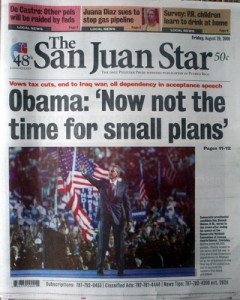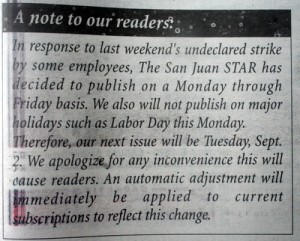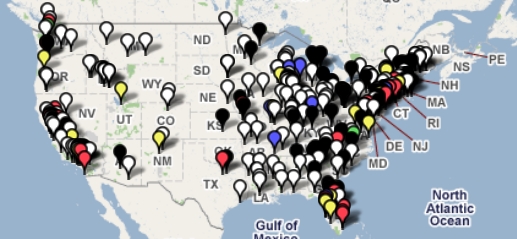Technorati has come out with its annual State of the Blogosphere report and some numbers are truly eye-popping. The site found blogs in 81 languages and daily posts are closing in on one million. Nearly 185 million people have started a blog (although most don’t tend them regularly). Newspapers have the bug: 95% of the top 100 US newspapers have reporter blogs. Four in five bloggers post brand or product reviews and 90% of bloggers say they post about the brands they love or hate. Most bloggers who accept advertising make a profit. Technorati did a big survey and got comments from various media influencers. We haven’t had a chance to read it all yet, but if you’re interested in publishing, you should check it out.
Meanwhile, The Politico, which is one of the more promising Web-only journalism ventures, is expanding. It will add employees, grow circulation of its Washington-area newspaper and and print more often. The staff will be expanded to at least 105 from its current 85. Circulation of its Capitol Hill newspaper will be increased 20% to 32,000 and a Monday issue will be added. All this will happen after the election, which is The Politico’s busiest season, but officials said there’s going to be plenty of news to keep people busy. Also, they expect to reach profitability next year, far ahead of schedule.
And perhaps there’s gold in them thar websites. BIA Financial Network and Borrell Associates have a new study that estimates that newspaper websites are the most lucrative local media around, with valuations of the largest properties reaching $450 million. That makes local alternatives like TV and radio small potatoes in comparison. “Given their growth potential, the value multiples of media Web sites may be 2 to 4 times that of the core business,” the BIA president is quoted as saying. The study also praises the strong cash flow at media websites. The problem is that growth is slowing. BTW, the $450 million number is only for the largest properties, so don’t get too excited. We estimate the market value of Newspaper Death Watch is about $1.23.
Miscellany
In the department of publishers that still don’t get it, we’d like to include The American Scholar, which publishes a provocative list of “12 Questions about the future of journalism” by Bill Kovach without offering visitors a way to respond. Um, guys, that’s part of the problem.
In chaos, there is opportunity, or at least that’s what Michelle Rafter says. She points to new launches at Slate, The Wall Street Journal, Silicon Valley Insider and Forbes as evidence that there’s opportunity in business journalism right now. Just make sure you get cash up front.
Death is good business, it seems. Tributes.com, which runs obituaries and related memorial messages, is teaming up with The Wall Street Journal to create a print counterpart to the website. For $80, you can buy a listing on Tributes.com where you can post photos and memories of a departed loved one. Now, for an additional $250, you can run your message in a dying medium, too. Tributes is a startup that was spun out of Eons, a social network for the over-50 crowd. Both are the brainchildren of Monster.com founder Jeff Taylor.
In the 80s, New York City brought us the Village People. Now it brings us TimesPeople. That’s The New York Times‘ new social network. “TimesPeople provides NYTimes.com readers with a way to share their thoughts and recommendations about The Times‘s content with other readers, making their public activities on the site more open,” says a company press release. Apparently you can only share your thoughts about Times content, not anybody else’s, which we suppose makes sense. You can also see the most recommended articles. The Times is a latecomer to the social networking world, trailing The Wall Street Journal by a whole eight days.
Scott Karp analyzes Matt Drudge’s influence and concludes “It’s the Links, Stupid.” The action in online publishing is in filtering and linking, not corralling your audience, he says. Drudge is successful because he tells cable TV and radio reporters what’s important and that shapes their daily broadcasts. Newspapers, in contrast, tend to tell people only what’s important in their pages on any one day, and that’s far less interesting to readers than a guide to that vast Worldwide Web. “In the web media era, when all news content is accessible by anyone, anywhere in the world, and no news brands no longer have a monopoly over news distribution, the power of influence lies in the ability to FILTER the vast sea of news,” he writes.
Layoff Log
- The Anchorage Daily News is reducing its staff by about 10%, laying off 13 employees and holding another dozen positions vacant.
- The Raleigh News & Observer has started making cuts after only 16 newsroom employees accepted a buyout offer. Its editorial cartoonist, a 33-year veteran, and ombudsmen will be cut back to part-time but their jobs won’t be eliminated.
- The Pittsburgh Post-Gazette is going to buy out or lay off workers unless it gets concessions from its unions. Between 10 and 20 Teamsters will lose their jobs, according to a union spokesman, but that’s just the beginning. The paper’s Ohio parent has been losing money for years and is threatening to sell its Pittsburgh property.
- As if the Seattle Times Co. didn’t need more headaches, now the truck drivers are threatening to strike. About 70 truckers could walk off the job on Oct. 21 in protest over the company’s bid to outsource its trucking to Penske Logistics.
- Threats by the publisher of the Newark Star-Ledger to close the paper if cost-cutting goals can’t be met have apparently put a bee in the Jockey shorts of the local union. The union representing 400 mailers at the paper agreed by a 10-1 margin to a three-year wage freeze and buyouts of a quarter of its members. The Star-Ledger is still looking to buy out another 200 of its 750 full-time nonunion employees.










